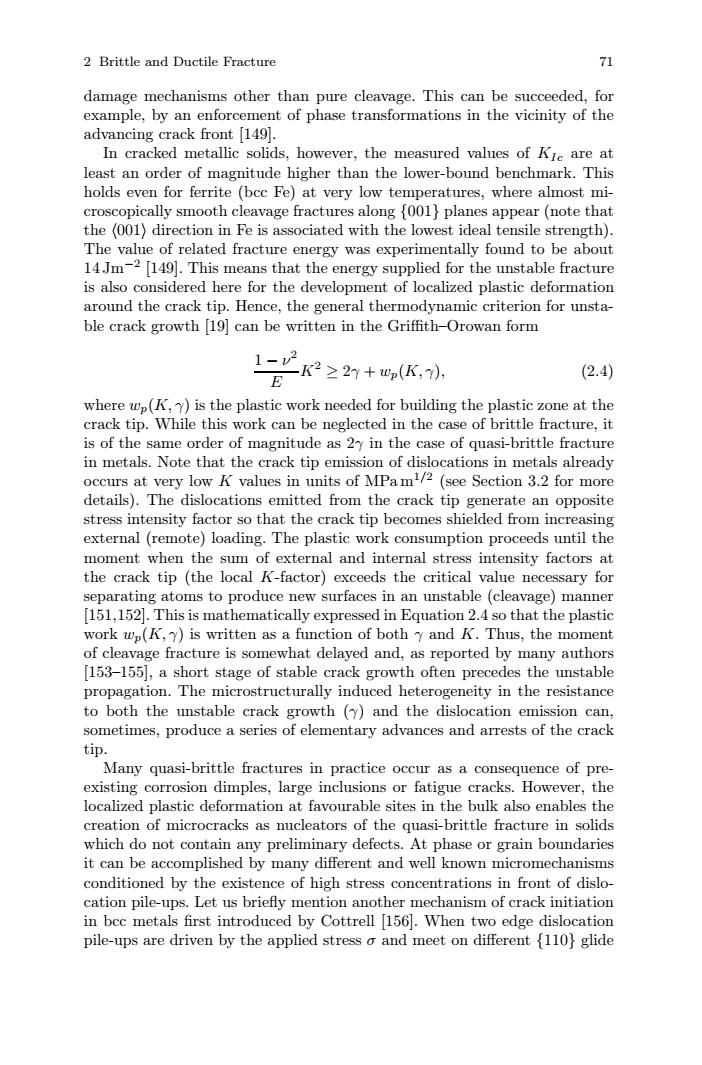正在加载图片...

2 Brittle and Ductile Fracture 71 damage mechanisms other than pure cleavage.This can be succeeded,for example,by an enforcement of phase transformations in the vicinity of the advancing crack front [149]. In cracked metallic solids,however,the measured values of Kic are at least an order of magnitude higher than the lower-bound benchmark.This holds even for ferrite (bcc Fe)at very low temperatures,where almost mi- croscopically smooth cleavage fractures along {001}planes appear(note that the(001)direction in Fe is associated with the lowest ideal tensile strength). The value of related fracture energy was experimentally found to be about 14Jm-2[149].This means that the energy supplied for the unstable fracture is also considered here for the development of localized plastic deformation around the crack tip.Hence,the general thermodynamic criterion for unsta- ble crack growth [19]can be written in the Griffith-Orowan form 1- EK2≥2+,(K,, (2.4) where wp(K,Y)is the plastic work needed for building the plastic zone at the crack tip.While this work can be neglected in the case of brittle fracture,it is of the same order of magnitude as 2 in the case of quasi-brittle fracture in metals.Note that the crack tip emission of dislocations in metals already occurs at very low K values in units of MPam1/2(see Section 3.2 for more details).The dislocations emitted from the crack tip generate an opposite stress intensity factor so that the crack tip becomes shielded from increasing external(remote)loading.The plastic work consumption proceeds until the moment when the sum of external and internal stress intensity factors at the crack tip (the local K-factor)exceeds the critical value necessary for separating atoms to produce new surfaces in an unstable(cleavage)manner (151,152.This is mathematically expressed in Equation 2.4 so that the plastic work wp(K,is written as a function of both y and K.Thus,the moment of cleavage fracture is somewhat delayed and,as reported by many authors [153-155],a short stage of stable crack growth often precedes the unstable propagation.The microstructurally induced heterogeneity in the resistance to both the unstable crack growth (y)and the dislocation emission can, sometimes,produce a series of elementary advances and arrests of the crack tip. Many quasi-brittle fractures in practice occur as a consequence of pre- existing corrosion dimples,large inclusions or fatigue cracks.However,the localized plastic deformation at favourable sites in the bulk also enables the creation of microcracks as nucleators of the quasi-brittle fracture in solids which do not contain any preliminary defects.At phase or grain boundaries it can be accomplished by many different and well known micromechanisms conditioned by the existence of high stress concentrations in front of dislo- cation pile-ups.Let us briefly mention another mechanism of crack initiation in bcc metals first introduced by Cottrell 156.When two edge dislocation pile-ups are driven by the applied stress o and meet on different {110}glide2 Brittle and Ductile Fracture 71 damage mechanisms other than pure cleavage. This can be succeeded, for example, by an enforcement of phase transformations in the vicinity of the advancing crack front [149]. In cracked metallic solids, however, the measured values of KIc are at least an order of magnitude higher than the lower-bound benchmark. This holds even for ferrite (bcc Fe) at very low temperatures, where almost microscopically smooth cleavage fractures along {001} planes appear (note that the 001 direction in Fe is associated with the lowest ideal tensile strength). The value of related fracture energy was experimentally found to be about 14 Jm−2 [149]. This means that the energy supplied for the unstable fracture is also considered here for the development of localized plastic deformation around the crack tip. Hence, the general thermodynamic criterion for unstable crack growth [19] can be written in the Griffith–Orowan form 1 − ν2 E K2 ≥ 2γ + wp(K, γ), (2.4) where wp(K, γ) is the plastic work needed for building the plastic zone at the crack tip. While this work can be neglected in the case of brittle fracture, it is of the same order of magnitude as 2γ in the case of quasi-brittle fracture in metals. Note that the crack tip emission of dislocations in metals already occurs at very low K values in units of MPa m1/2 (see Section 3.2 for more details). The dislocations emitted from the crack tip generate an opposite stress intensity factor so that the crack tip becomes shielded from increasing external (remote) loading. The plastic work consumption proceeds until the moment when the sum of external and internal stress intensity factors at the crack tip (the local K-factor) exceeds the critical value necessary for separating atoms to produce new surfaces in an unstable (cleavage) manner [151,152]. This is mathematically expressed in Equation 2.4 so that the plastic work wp(K, γ) is written as a function of both γ and K. Thus, the moment of cleavage fracture is somewhat delayed and, as reported by many authors [153–155], a short stage of stable crack growth often precedes the unstable propagation. The microstructurally induced heterogeneity in the resistance to both the unstable crack growth (γ) and the dislocation emission can, sometimes, produce a series of elementary advances and arrests of the crack tip. Many quasi-brittle fractures in practice occur as a consequence of preexisting corrosion dimples, large inclusions or fatigue cracks. However, the localized plastic deformation at favourable sites in the bulk also enables the creation of microcracks as nucleators of the quasi-brittle fracture in solids which do not contain any preliminary defects. At phase or grain boundaries it can be accomplished by many different and well known micromechanisms conditioned by the existence of high stress concentrations in front of dislocation pile-ups. Let us briefly mention another mechanism of crack initiation in bcc metals first introduced by Cottrell [156]. When two edge dislocation pile-ups are driven by the applied stress σ and meet on different {110} glide